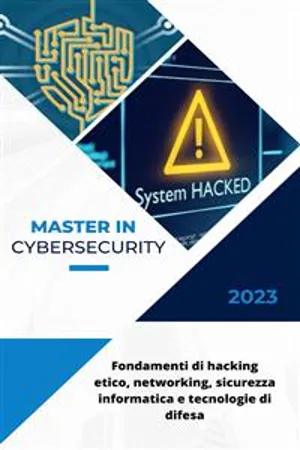
Cybersecurity: Fondamenti di hacking etico, networking, sicurezza informatica e tecnologie di difesa
Non si tratta di se, ma di quando.
- English
- PDF
- Available on iOS & Android
Cybersecurity: Fondamenti di hacking etico, networking, sicurezza informatica e tecnologie di difesa
Non si tratta di se, ma di quando.
About this book
Il Master in Cybersicurezza fornisce una formazione completa sui fondamenti dell'hacking etico, della sicurezza informatica e delle tecnologie di difesa. Il corso si concentra sulla differenza tra hacking etico e hacking malintenzionato, gli standard di sicurezza informatica e l'importanza della cybersicurezza. Gli studenti acquisiranno una conoscenza dettagliata della struttura e del funzionamento delle reti, dei protocolli di rete e del modello OSI. Inoltre, gli studenti impareranno i fondamenti di Linux, inclusi la command line, il file system e la gestione dei pacchetti. Il corso esplora anche i concetti di vulnerabilità, minacce e attacchi informatici, le tecniche di difesa e i meccanismi di difesa contro gli attacchi informatici, incluso l'utilizzo di password sicure. Gli studenti acquisiranno una conoscenza approfondita sulla protezione delle informazioni, la crittografia e la protezione della privacy online. Inoltre, il corso si concentra sulla sicurezza aziendale, con informazioni su come proteggere i dati aziendali e sulle politiche di sicurezza informatica nelle aziende. Gli studenti impareranno a scoprire e analizzare le vulnerabilità comuni nei sistemi web, inclusi SQL injection, XSS e CSRF, nonché a utilizzare gli strumenti di hacking più comuni, come Nmap, Metasploit, Wireshark, John the Ripper e Aircrack-ng, tra gli altri. Inoltre, gli studenti approfondiranno le analisi di vulnerabilità avanzate, come il buffer overflow e l'injection di codice. Il corso si concentra anche sulle tecnologie di sicurezza, inclusi i firewall e gli IDS/IPS, nonché sui sistemi wireless come WiFi, Bluetooth e Zigbee. Inoltre, gli studenti acquisiranno una comprensione sulla scansione automatica di vulnerabilità e sulla gestione delle vulnerabilità. Il corso si conclude con una riflessione sull'etica e la legalità dell'hacking etico, con informazioni sull'impatto dell'hacking etico sulla società e sulla responsabilità legale dell'hacker etico.
Frequently asked questions
- Essential is ideal for learners and professionals who enjoy exploring a wide range of subjects. Access the Essential Library with 800,000+ trusted titles and best-sellers across business, personal growth, and the humanities. Includes unlimited reading time and Standard Read Aloud voice.
- Complete: Perfect for advanced learners and researchers needing full, unrestricted access. Unlock 1.4M+ books across hundreds of subjects, including academic and specialized titles. The Complete Plan also includes advanced features like Premium Read Aloud and Research Assistant.
Please note we cannot support devices running on iOS 13 and Android 7 or earlier. Learn more about using the app.
Information
Table of contents
- Title
- Copyright
- Master in Cybersecurity: Fondamenti di hacking etico, networking, sicurezza informatica e tecnologie di difesa
- Capitolo 1: Introduzione all'hacking etico e alla sicurezza informatica
- • Differenze tra hacking etico e hacking malintenzionato
- • Standard di sicurezza informatica
- • Perché la cybersicurezza è importante
- • Leggi e etiche dell'hacking etico
- Capitolo 2: Fondamenti di networking e protocolli di rete
- • Struttura e funzionamento delle reti
- • Protocolli di rete
- • Modello OSI
- Capitolo 3: Fondamenti di Linux
- • Command line
- • File system
- • Gestione dei pacchetti
- Capitolo 4: Fondamenti di sicurezza informatica
- • Concetti di vulnerabilità, minacce e attacchi informatici
- • Difese e tecniche di sicurezza
- • Meccanismi di difesa contro gli attacchi informatici
- • Utilizzo di password sicure
- Capitolo 5: Protezione delle informazioni
- • Come proteggere le informazioni sensibili
- • Crittografia: cos'è e come funziona
- • Come proteggere la propria privacy online
- • Utilizzo di password sicure
- Capitolo 6: Sicurezza aziendale
- • Minacce informatiche alle aziende
- • Come proteggere i dati aziendali
- • Politiche di sicurezza informatica nelle aziende
- • Formazione dei dipendenti sulla sicurezza informatica
- Capitolo 7: Scoperta e analisi delle vulnerabilità comuni nei sistemi web
- Capitolo 7: Scoperta e analisi delle vulnerabilità comuni nei sistemi web
- • SQL injection
- • XSS
- • CSRF
- Capitolo 8: Strumenti di hacking
- • Nmap
- • Metasploit
- • Wireshark
- • John the Ripper
- • Aircrack-ng
- • Altri strumenti di hacking
- Capitolo 9: Analisi di vulnerabilità avanzate
- • Buffer overflow
- • Injection di codice
- Capitolo 10: Tecnologie di sicurezza
- • Firewall
- • IDS/IPS
- Capitolo 11: Hacking di sistemi wireless
- • WiFi
- • Bluetooth
- • Zigbee
- Capitolo 12: Analisi di vulnerabilità su larga scala
- • Scansione automatica di vulnerabilità
- • Gestione delle vulnerabilità
- Capitolo 13: Etica e legalità dell'hacking etico
- • Impatto dell'hacking etico sulla società
- • Responsabilità legale dell'hacker etico
- Conclusioni
- • La cybersicurezza come sfida continua.